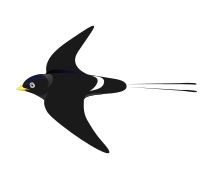
Back سنونو النهر Arabic سنونو النهر ARZ Pseudochelidon Breton Pseudochelidon Catalan Pseudochelidon CEB Riverhirundoj Esperanto Pseudochelidoninae Spanish چلچلههای رودخانهای Persian Jokipääskyt Finnish Pseudochelidon French
| River martins | |
|---|---|

| |
| White-eyed river martin (Pseudochelidon sirintarae) | |
| Scientific classification | |
| Domain: | Eukaryota |
| Kingdom: | Animalia |
| Phylum: | Chordata |
| Class: | Aves |
| Order: | Passeriformes |
| Family: | Hirundinidae |
| Subfamily: | Pseudochelidoninae Shelley, 1896 |
| Genus: | Pseudochelidon Hartlaub, 1861 |
| Type species | |
| Pseudochelidon eurystomina[1] Hartlaub, 1861
| |
| Species | |
The river martins form a distinctive subfamily Pseudochelidoninae within the swallow and martin bird family Hirundinidae. The two species are the African river martin Pseudochelidon eurystomina, found in the Congo and Gabon, and the white-eyed river martin Pseudochelidon sirintarae, known only from one site in Thailand. These are medium-sized, largely black swallows that have a light buoyant flight and feed on insects caught in the air. They appear to be more terrestrial than other swallows, frequently walking rather than perching, and the white-eyed may be crepuscular. The African species excavates nest holes in sandy ridges in rivers, while the breeding locations and habits of the Asian bird are unknown.
When the African river martin was first discovered in the 19th century, Gustav Hartlaub thought it was a roller, and later authors either placed it in its own family, or with the woodswallows. Study of the anatomy revealed that the species was closest to the swallows and martins, but that it possessed a number of distinctive features, such as its robust legs and feet and stout bill. These indicated that it should be placed in a separate subfamily. The two river martin species are usually considered to belong to a single genus, Pseudochelidon, due to their having a number of structural similarities. However, Brooke proposed that the white-eyed river martin be placed in a separate monotypic genus Eurochelidon.
The African river martin has a restricted distribution; it appears to be locally numerous, although its true status has not been fully investigated. The white-eyed river martin was discovered as recently as 1969 and is only known from specimens and anecdotal evidence – no modern ornithologists have seen the species in the wild, and its breeding grounds are unknown. It may be extinct, although a possible sighting was reported in 2004.
- ^ "Hirundinidae". aviansystematics.org. The Trust for Avian Systematics. Retrieved 2023-07-15.